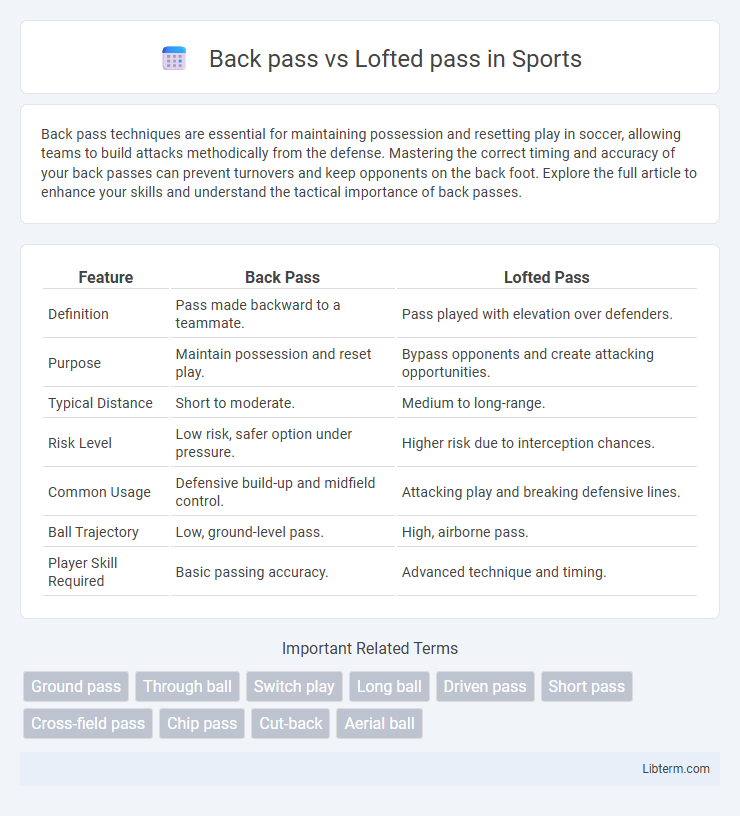Back pass techniques are essential for maintaining possession and resetting play in soccer, allowing teams to build attacks methodically from the defense. Mastering the correct timing and accuracy of your back passes can prevent turnovers and keep opponents on the back foot. Explore the full article to enhance your skills and understand the tactical importance of back passes.
Table of Comparison
| Feature | Back Pass | Lofted Pass |
|---|---|---|
| Definition | Pass made backward to a teammate. | Pass played with elevation over defenders. |
| Purpose | Maintain possession and reset play. | Bypass opponents and create attacking opportunities. |
| Typical Distance | Short to moderate. | Medium to long-range. |
| Risk Level | Low risk, safer option under pressure. | Higher risk due to interception chances. |
| Common Usage | Defensive build-up and midfield control. | Attacking play and breaking defensive lines. |
| Ball Trajectory | Low, ground-level pass. | High, airborne pass. |
| Player Skill Required | Basic passing accuracy. | Advanced technique and timing. |
Introduction to Back Pass and Lofted Pass
Back pass and lofted pass are essential football techniques differing primarily in trajectory and purpose. A back pass involves passing the ball backward to a teammate, usually for maintaining possession or resetting play, often executed with the sole or instep to ensure accuracy and control. Lofted passes elevate the ball off the ground, allowing it to cover longer distances and bypass opponents, typically used for advancing attack or switching play direction effectively.
Defining Back Pass in Football
A back pass in football refers to a deliberate pass made by a player to a teammate positioned behind them, often used to maintain possession or reset play. Unlike a lofted pass, which is typically played with height and distance to overcome opponents, a back pass is usually short, ground-based, and designed for safe ball control. Understanding the rules around back passes is crucial, as goalkeepers are prohibited from handling the ball when receiving a back pass from a teammate.
Understanding the Lofted Pass
A lofted pass is a soccer technique where the ball is kicked with an upward trajectory to bypass opponents and reach a teammate in an open space, enhancing strategic play in tight defenses. This aerial pass contrasts with a back pass, which is played along the ground toward a defensive player, primarily to maintain possession and reset play. Mastering the lofted pass requires precise timing and positioning to control ball height and distance, increasing the chances of successful offensive opportunities.
Key Differences: Back Pass vs Lofted Pass
A back pass involves passing the ball directly backward to a teammate, typically used for maintaining possession and quick defensive resets. In contrast, a lofted pass lifts the ball into the air with a higher trajectory, allowing players to bypass opponents and cover longer distances quickly. Key differences include the back pass's emphasis on precision and control, while the lofted pass prioritizes evading pressure and exploiting space behind defenders.
Tactical Advantages of Back Pass
The back pass provides tactical advantages by maintaining possession under pressure, enabling team players to reset and reorganize their formation effectively. This strategic move minimizes risks compared to lofted passes, which are more susceptible to interceptions due to their high trajectory and slower speed. Utilizing back passes enhances ball control and supports a disciplined buildup, optimizing field positioning and reducing turnovers.
Situational Benefits of the Lofted Pass
A lofted pass excels in bypassing dense defensive lines and creating more space for attacking players by delivering the ball over opponents. It is particularly effective in fast-break situations or when teammates are positioned far apart, allowing for quicker ball progression. The elevated trajectory of a lofted pass reduces interception risks compared to ground passes in congested areas.
Common Mistakes and Risks
Back passes often result in loss of momentum and create vulnerability to interceptions if executed without proper vision and timing. Lofted passes carry the risk of inaccurate ball placement and increased vulnerability to opponent interceptions due to their slower flight and higher trajectory. Common mistakes include underestimating opponent positioning for back passes and overhitting lofted passes, causing loss of possession or missed scoring opportunities.
Training Drills for Mastery
Training drills for mastering back passes emphasize precise foot placement and timing to maintain ball control and team positioning, often including wall passes and short-range combination plays to enhance accuracy under pressure. Lofted pass drills focus on developing a player's ability to gauge distance and trajectory, using cone targets and partner receiving exercises to perfect aerial ball delivery over defenders. Incorporating both drills into regular practice sessions builds versatile passing skills crucial for dynamic game strategies.
Impact on Team Strategy and Possession
A back pass emphasizes retaining possession by allowing defenders or midfielders to reset play and maintain team structure, reducing risk of losing the ball in critical areas. Lofted passes, while riskier due to their aerial nature, can strategically bypass pressure and launch rapid attacks, disrupting opponent formations and creating scoring opportunities. Balancing these passing types influences team tempo and defensive solidity, directly impacting overall possession control and tactical execution.
Choosing the Right Pass in Match Scenarios
Choosing the right pass in match scenarios depends on player positioning and game dynamics. A back pass offers safer possession retention, ideal for maintaining control under pressure or resetting the play. Lofted passes are strategic for bypassing defenders and reaching teammates in advanced positions, particularly effective during counterattacks or to exploit spaces behind a defensive line.
Back pass Infographic

 libterm.com
libterm.com